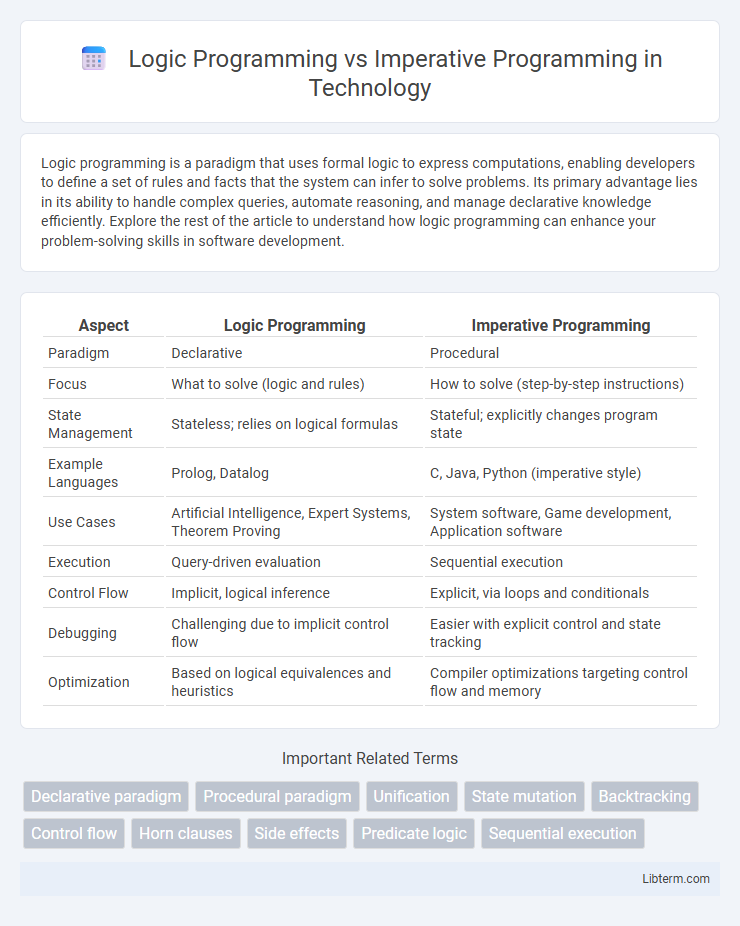Logic programming is a paradigm that uses formal logic to express computations, enabling developers to define a set of rules and facts that the system can infer to solve problems. Its primary advantage lies in its ability to handle complex queries, automate reasoning, and manage declarative knowledge efficiently. Explore the rest of the article to understand how logic programming can enhance your problem-solving skills in software development.
Table of Comparison
| Aspect | Logic Programming | Imperative Programming |
|---|---|---|
| Paradigm | Declarative | Procedural |
| Focus | What to solve (logic and rules) | How to solve (step-by-step instructions) |
| State Management | Stateless; relies on logical formulas | Stateful; explicitly changes program state |
| Example Languages | Prolog, Datalog | C, Java, Python (imperative style) |
| Use Cases | Artificial Intelligence, Expert Systems, Theorem Proving | System software, Game development, Application software |
| Execution | Query-driven evaluation | Sequential execution |
| Control Flow | Implicit, logical inference | Explicit, via loops and conditionals |
| Debugging | Challenging due to implicit control flow | Easier with explicit control and state tracking |
| Optimization | Based on logical equivalences and heuristics | Compiler optimizations targeting control flow and memory |
Introduction to Programming Paradigms
Logic programming emphasizes declarative problem-solving through formal logic and facts, enabling programs to determine conclusions from given rules. Imperative programming relies on explicit sequences of commands that change program state through variables and control structures. This fundamental difference in expressing computations distinguishes these paradigms within programming paradigms.
What is Logic Programming?
Logic programming is a paradigm based on formal logic where programs consist of a set of facts and rules used to infer conclusions through automated reasoning. It emphasizes declarative problem-solving, allowing the programmer to specify *what* the problem is rather than *how* to solve it, in contrast to imperative programming that requires explicit step-by-step instructions. Prolog is a prominent logic programming language that exemplifies this approach, enabling complex queries and symbolic reasoning with minimal procedural code.
Defining Imperative Programming
Imperative programming is a paradigm centered on explicit commands that change a program's state through statements and control structures like loops and conditionals. It emphasizes step-by-step instructions for the computer to follow, often manipulating variables and memory directly to achieve desired outcomes. Key languages exemplifying this approach include C, Java, and Python, where the flow of execution is determined by the sequence of commands written by the programmer.
Core Principles: Logic vs Imperative
Logic programming centers on declarative statements and uses formal logic to express facts and rules, enabling automated inference and problem-solving through unification and backtracking. Imperative programming defines explicit step-by-step instructions and state changes, relying on control flow structures like loops and conditionals to produce computational results. The core distinction lies in logic programming's foundation on *what* to solve, contrasting with imperative programming's emphasis on *how* to solve a problem.
Syntax and Structure Differences
Logic programming uses declarative syntax focused on defining facts and rules, allowing the system to infer conclusions, while imperative programming employs step-by-step instructions and control flow statements like loops and conditionals. In logic programming languages such as Prolog, the structure is based on predicates and logical clauses, emphasizing what to solve rather than how to solve it. Imperative languages like C or Java organize code into sequences of commands and procedures, prioritizing explicit state changes and algorithmic flow.
Execution Model Comparison
Logic programming executes by defining facts and rules, relying on a declarative approach where the interpreter searches for solutions through pattern matching and backtracking. Imperative programming follows a sequential execution model, manipulating variables with explicit control structures like loops and conditionals to change state step-by-step. While logic programming emphasizes what to solve, imperative programming focuses on how to perform tasks through direct commands.
Key Use Cases and Applications
Logic programming excels in knowledge representation, artificial intelligence, and problem-solving tasks that require symbolic reasoning and rule-based inference, such as expert systems and natural language processing. Imperative programming is preferred for system software, game development, and applications demanding precise control over hardware and performance, including operating systems and real-time simulations. Each paradigm offers unique strengths tailored to their core use cases, with logic programming focusing on declarative problem specifications and imperative programming on explicit algorithmic processes.
Performance and Efficiency Considerations
Logic programming excels in symbolic reasoning and complex problem-solving but often suffers from slower execution times and higher memory usage compared to imperative programming languages like C or Java, which offer fine-grained control over hardware resources. Imperative programming efficiently manages state changes and resource allocation, resulting in faster performance and lower runtime overhead, especially in computationally intensive tasks. Optimizing performance in logic programming requires advanced techniques such as constraint propagation and indexing, while imperative programming benefits from compiler optimizations and direct manipulation of memory.
Learning Curve and Community Support
Logic programming, exemplified by languages like Prolog, features a steep learning curve due to its declarative nature and reliance on formal logic, which can be challenging for beginners accustomed to imperative paradigms. Imperative programming languages such as Python, Java, and C++ benefit from extensive community support, offering abundant tutorials, forums, and libraries that facilitate quicker skill acquisition and problem-solving. The vibrant communities and broad industry adoption of imperative languages provide learners with robust resources and collaborative opportunities, whereas logic programming communities, though smaller, offer specialized support for complex reasoning and AI-related tasks.
Choosing the Right Paradigm for Your Project
Choosing the right programming paradigm depends on the project requirements, complexity, and desired level of abstraction. Logic programming excels in symbolic reasoning, knowledge representation, and problems involving constraints or rule-based logic, making it ideal for AI and expert systems. Imperative programming suits tasks requiring precise control over state changes and step-by-step algorithms, commonly used in system software and performance-critical applications.
Logic Programming Infographic

 libterm.com
libterm.com